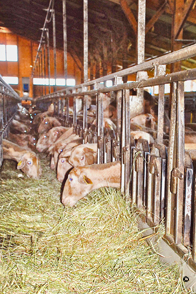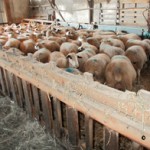A coach-load of US sheep folks toured French sheep farms last September. It included a full day at Tech-Ovin (a biennial French one-day event that brings together the latest sheep industry ideas and equipment).
I’m still trying to analyze what we saw and that which we “heard”. The hearing was difficult because our translator/guide chose not to bring along a megaphone so it was hard to hear him consistently.
In a nutshell?
- We visited 2 meat sheep farms, 1 dairy sheep farm (supplies the Roquefort cheese market), 1 dairy goat farm and 1 meat/wool farm. The latter was a case of chance and circumstance that occurred because it had a farm restaurant—that served us some of the best lamb I’ve ever encountered.
- All except one had over 1000 ewes or dairy goats. Obviously we didn’t expect to be taken to the smallest sheep farm. Nonetheless the scale of the operations was a surprise.
- All had a stunning amount of equipment including many tractors (latest), TMR (total mixed ration) wagons, huge manure spreaders, big square balers, heavy-duty all-terrain material handlers, etc.
- All had an equally stunning array of large barns with automated feeders (2 fed grain with overhead robots that moved on long support pipes), in-barn hay-dryers that produced very high quality alfalfa hay, powered feed conveyors and mechanized manger feeding stations for 1000’s of animals.
- Most of the places visited (75%) were seriously expanding—while the French sheep industry, according to InterBev (France’s Meat and Livestock Assoc.), is shrinking—15% over last 10 years. The dichotomy puzzles. I sense the large are getting larger and the smaller operations are exiting.
- Several used sponges for synchronized breeding and artificial insemination (with fresh semen) – on 1000’s of ewes and/or goats per year. The cost/head was much less than in the USA.
- We visited the largest French live sheep market (in Requista). It was very modern. But there was no auctioneer. Instead a bell sounds for a given class of sheep (light lambs, export lambs, ewes) and the seller walks to the front of his sheep pens. The buyers meet them there, brief man-to-man negotiations occur and it’s over—in less than 15 minutes.
- No (that we could see) sheep handling yards. I suspect they rely on mechanized mangers to restrain the adult animals but I cannot be sure as that question wasn’t, to my knowledge asked.
- The dairy sheep (Lacaune) farm synchronized the breeding (AI) and the ewes lambed together in groups of 20. But there were no individual lambing jugs. I still marvel at that. They said it worked well. The lambs are weaned at 35 days and the ewes milked thereafter. (I think the latter was true but again, cannot be sure as it a was a large group with a less than wonderful translator.)
- Aseasonal breeds appeared to be common. So lambing occurs throughout the year (3 in 2 yrs, 4 in 3 yrs, etc). Perhaps the resulting increased productivity per ewe explains/supports the extra buildings and equipment?
- Not many of the lambs are pastured prior to slaughter. Most are kept inside and sold before they reach 80 lbs live-weight (some at 40–50 lbs).
- Terminal sire breeds must produce lambs with saleable cuts with a high meat to bone ratio at an early age and low carcass weight (Berrichon du Cher, Ile de France).
- Compared to the USA there is both more regulation and more technical support from the French govt. and regional organizations for the sheep industry.
I include a pdf that you may download if you wish that provides yet more detail. It’s a snapshot of one of several regional organizations. Caussenard sheep data
The tour left we US folks with these questions.
- How to the french sheep farmers afford all of that equipment—far more than we US folks can afford? (We joked among ourselves that they have a tractor for every 25 ewes.)
- Best guesses?
- Unlike US sheep producers the French have received decades of useful govt. subsidies—often amounting to over 33% of the annual “sheep income”. Until recently these subsidies were based on euros per head—which is significant incentive to keep smaller ewes.
- The market for lamb and sheep milk is more stable than in the USA. So sheep farmers are able to make long-term investments.
- Both farm equipment and buildings can be fully expensed against taxes in the year of purchase. This policy (recently true in the USA) is a significant advantage to the profitable farms and/or those with off-farm taxable income—but it puts cash-poor new and/or smaller sheep farmers at a comparative disadvantage.
- Why have most USA efforts at intensive sheep production similar to the French been failures?
- Why do the French sheep and dairy goat farmers, unlike those anywhere else I’ve visited (UK, N. Zealand, Australia, Mexico, USA, Germany) so often feed sheep with mechanized mangers (see photos)? It’s a notable extra investment so they must save feed and make sheep handling easier.
- Has anyone in the USA studied the Caussenard breed closely? No one on the trip had heard of it. Yes the wool is of no value (due to kemp)—but it has many characteristics that might be useful—can be raised indoors or out, relaxed temperament, reasonable frame, thrives on low-quality feed, aseasonal ovulation.
Overall conclusion? It merits a second visit to some of the same farms—this time with more time at each stop and a much better translator.





